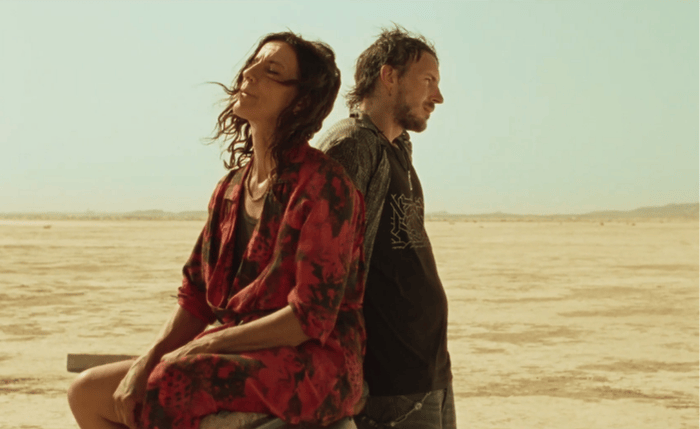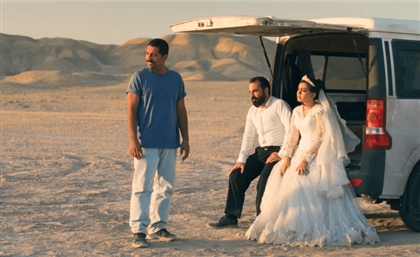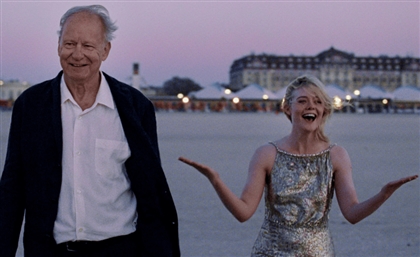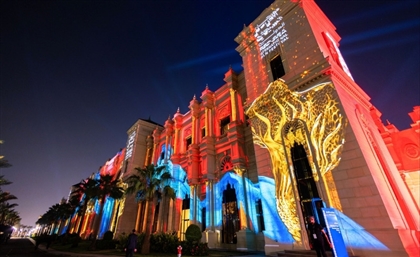Cannes Review: ‘Sirat’ Is a Journey Through Hell
Six years after ‘Viendra le feu’ (2019) won the Un Certain Regard Jury Prize, Oliver Laxe returns with Sirat.

Originally published on May 22nd, 2025.
A rave erupts in the heart of the Moroccan desert. Speakers throb like engines in the sand. The dirty clearing is surrounded by the Atlas Mountains looming large. The air is thick with dust. Every stomp of bare or booted feet kicks up clouds of it into the air. As the camera glides through the crowd, we see a layer of sand clinging to everyone. The sand is coating everyone’s skin and sticking to their sweat-soaked clothes. It’s as if the earth beneath their feet is trying to swallow them whole.
The ravers look like a tribe of outcasts. Some dance with missing limbs. Others in patched, shredded clothing. Yet they seem free. The beat moves through them like a current. It syncs their bodies into one convulsing organism. Most of them look like they’ve stumbled out of a Mad Max film. Except for one man. He walks among them, out of place, out of sync. Clutched in his hands are flyers of his missing daughter. Behind him trails his son and a small puppy. The music keeps pulsing. He keeps searching.
Six years after Viendra le feu (2019) won the Un Certain Regard Jury Prize, Oliver Laxe returns with Sirat. Only this time, this co-production between Spain and Morocco is competing in the main competition. The film takes its name from the Sirat Bridge in Islamic tradition. According to tradition, the Sirat Bridge is a razor-thin path suspended over Hell that every soul must cross on the Day of Judgment. Only the righteous will make it safely to Paradise. It symbolises the ultimate test of morality. The film follows a father on a spiritual journey through the desert. The landscape becomes that bridge between life and death.
We soon learn that he and his son have been searching for his missing daughter for five months. One of the ravers sympathizes with the old man. She tells him about another rave that is set to take place after this one. Only it’ll take place much deeper in the desert. When he asks if she and her group are going there, they don’t give him a clear answer. But he can sense it. That’s where they’re headed next. And maybe, just maybe, that’s where his daughter is.
Laxe uses 16mm film to capture their journey through hell. The grainy texture gives the images a psychedelic quality. In one hypnotic shot, the camera is fixed to the back of a moving truck facing the street. The ground seems to glide. Pebbles smear past in streaks. Then a single white line emerges, slicing the road in two. It holds steady for a moment, then breaks into dashes. The faster they move, the more abstract the road becomes.
The old man and the ravers are taking a backroad to avoid the main one which is swamped with army vehicles and checkpoints. Not unlike the Sinai desert in Egypt. Soon, the journey gets harder. With no other route, they’re forced to drive through the mountains. Laxe clearly nods to Sorcerer, William Friedkin’s remake of Henri-Georges Clouzot’s The Wages of Fear. Like those films, Sirat becomes a battle between man and nature. But here, the desert is even more punishing than the Latin American jungle. Narrow dirt roads snake up the mountain. One wrong turn and it's all over. As if that weren’t enough, the land is scattered with mines left behind from World War II. Every inch forward is a gamble.
The suspense is relentless. There were long stretches where I found myself at the edge of my seat. One scene in particular left me in complete shock. I gasped and covered my mouth. It’s an image I’ll likely never forget. I doubt I’ll see a more jaw-dropping moment at Cannes this year. I have a strong feeling this film will walk away with an award, possibly Best Actor for Sergi López. His performance is the emotional core of the film.
If there’s one aspect that left me wanting more, it’s the ending. After such a gripping, visually arresting journey, the film’s final moments felt slightly underwhelming. It doesn’t quite deliver the emotional payoff you might expect from a story rooted in loss. But perhaps that’s the point. Closure is not always granted, especially in the wake of devastation. Sirat operates as both a physical and metaphysical journey between grief and transcendence. Laxe constructs a cinematic odyssey through purgatory. By the time it ends, you’re relieved. Not because it doesn’t deliver, but because it leaves you physically and emotionally drained.
- Previous Article More Global Stars Join Red Sea Film Festival's “In Conversation”
- Next Article Riyadh Launches Citywide Volunteers Day on December 8th
Trending This Week
-
Dec 04, 2025



























